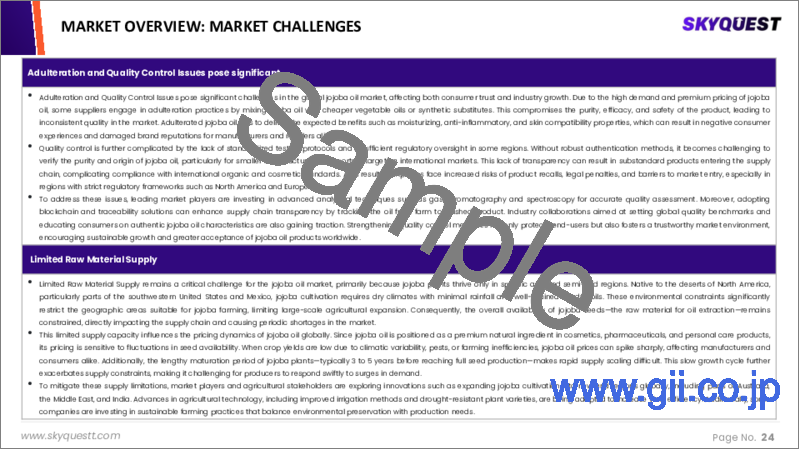|
|
市場調査レポート
商品コード
1646260
ホホバオイルの市場規模、シェア、成長分析:抽出方法別、オーガニック別、用途別、最終用途別、地域別 - 産業予測 2025~2032年Jojoba Oil Market Size, Share, Growth Analysis, By Extraction Method (Cold pressing, Solvent extraction), By Organic (Natural, Refined), By Application, By End-Use, By Region - Industry Forecast 2025-2032 |
||||||
|
|||||||
| ホホバオイルの市場規模、シェア、成長分析:抽出方法別、オーガニック別、用途別、最終用途別、地域別 - 産業予測 2025~2032年 |
|
出版日: 2025年01月25日
発行: SkyQuest
ページ情報: 英文 236 Pages
納期: 3~5営業日
|
全表示
- 概要
- 目次
ホホバオイル市場規模は2023年に1億3,080万米ドルとなり、予測期間(2025-2032年)のCAGRは7.7%で、2024年の1億4,087万米ドルから2032年には2億5,501万米ドルに成長する見通しです。
ホホバオイル市場は、化粧品、医薬品、工業分野での多様な用途によって力強い成長を遂げています。種子中に45~55%の油分を含むホホバオイルは、マッコウクジラの脂肪の化学的特性を反映しており、皮膚の保護やアンチエイジング効果があるため、高圧潤滑剤、化粧品、スキンケア製品に最適です。医薬品や安定剤の担体としての利用により、その用途はさらに広がります。コールドプレス抽出法はオイルの栄養的完全性を維持するが、収率が低いなどの課題があります。しかし、ホホバデザートのコンタミネーションフリープロダクションに代表されるように、自動化とAIの進歩が新たな動向となっています。その結果、米国のホホバオイル市場は、品質と環境の持続可能性を重視するメーカーにとって魅力的であり、今後数年間は持続可能な成長が見込まれます。
目次
イントロダクション
- 調査の目的
- 調査範囲
- 定義
調査手法
- 情報調達
- 二次データと一次データの方法
- 市場規模予測
- 市場の前提条件と制限
エグゼクティブサマリー
- 世界市場の見通し
- 供給と需要の動向分析
- セグメント別機会分析
市場力学と見通し
- 市場概要
- 市場規模
- 市場力学
- 促進要因と機会
- 抑制要因と課題
- ポーターの分析
主な市場の考察
- 重要成功要因
- 競合の程度
- 主な投資機会
- 市場エコシステム
- 市場の魅力指数(2024年)
- PESTEL分析
- マクロ経済指標
- バリューチェーン分析
- 価格分析
ホホバオイル市場規模:抽出方法別& CAGR(2025-2032)
- 市場概要
- コールドプレス
- 溶媒抽出
- 純粋
ホホバオイル市場規模:オーガニック別 & CAGR(2025-2032)
- 市場概要
- 天然
- 精製
ホホバオイル市場規模:用途別& CAGR(2025-2032)
- 市場概要
- 化粧品・パーソナルケア
- 医薬品
- 飲食品
- 産業用
ホホバオイル市場規模:最終用途別& CAGR(2025-2032)
- 市場概要
- ヘアケア
- スキンケア
- 化粧品
- 栄養補助食品
ホホバオイル市場規模:地域別& CAGR(2025-2032)
- 北米
- 米国
- カナダ
- 欧州
- ドイツ
- スペイン
- フランス
- 英国
- イタリア
- その他欧州地域
- アジア太平洋地域
- 中国
- インド
- 日本
- 韓国
- その他アジア太平洋地域
- ラテンアメリカ
- ブラジル
- その他ラテンアメリカ地域
- 中東・アフリカ
- GCC諸国
- 南アフリカ
- その他中東・アフリカ
競合情報
- 上位5社の比較
- 主要企業の市場ポジショニング(2024年)
- 主な市場企業が採用した戦略
- 市場の最近の動向
- 企業の市場シェア分析(2024年)
- 主要企業の企業プロファイル
- 会社概要
- 製品ポートフォリオ分析
- セグメント別シェア分析
- 収益の前年比比較(2022-2024)
主要企業プロファイル
- Purcell Jojoba(United States)
- Organic Crop Protectants(Australia)
- Jojoba Naturals(United States)
- Jojoba Desert(Israel)
- Hallstar(United States)
- Nutrix International LLC(United States)
- US Organic Group Corp.(United States)
- Herbo Nutra(India)
- The Jojoba Company Australia(Australia)
- Deborah Group(Italy)
- Murad LLC(United States)
- L'Oreal S.A.(France)
- Earth Expo Company(India)
- Inca Oil SA(Argentina)
- Ecooil(Argentina)
- OPW Ingredients GmbH(Germany)
- Desert Whale Jojoba Company(United States)
結論と推奨事項
Jojoba Oil Market size was valued at USD 130.8 million in 2023 and is poised to grow from USD 140.87 million in 2024 to USD 255.01 million by 2032, growing at a CAGR of 7.7% during the forecast period (2025-2032).
The jojoba oil market is experiencing robust growth driven by its diverse applications in cosmetics, pharmaceuticals, and industrial sectors. With 45-55% oil content in its seeds, jojoba oil mirrors the chemical properties of sperm whale fat, making it ideal for high-pressure lubricants, cosmetics, and skin-care products due to its skin-protecting and anti-aging benefits. Its utilization as a carrier for pharmaceuticals and stabilizers further broadens its reach. The cold-pressed extraction method maintains the oil's nutritional integrity but presents challenges like low yield. However, advancements in automation and AI, exemplified by Jojoba Desert's contamination-free production, are emerging trends. As a result, the US jojoba oil market is poised for sustainable growth in the coming years, appealing to manufacturers focused on quality and environmental sustainability.
Top-down and bottom-up approaches were used to estimate and validate the size of the Jojoba Oil market and to estimate the size of various other dependent submarkets. The research methodology used to estimate the market size includes the following details: The key players in the market were identified through secondary research, and their market shares in the respective regions were determined through primary and secondary research. This entire procedure includes the study of the annual and financial reports of the top market players and extensive interviews for key insights from industry leaders such as CEOs, VPs, directors, and marketing executives. All percentage shares split, and breakdowns were determined using secondary sources and verified through Primary sources. All possible parameters that affect the markets covered in this research study have been accounted for, viewed in extensive detail, verified through primary research, and analyzed to get the final quantitative and qualitative data.
Jojoba Oil Market Segments Analysis
Global Jojoba Oil Market is segmented by Extraction Method, Organic, Application, End-Use and region. Based on Extraction Method, the market is segmented into Cold pressing, Solvent extraction and Purity. Based on Organic, the market is segmented into Natural and Refined. Based on Application, the market is segmented into Cosmetics and personal care, Pharmaceuticals, Food and beverages and Industrial. Based on End-Use, the market is segmented into Hair care, Skin care, Cosmetics and Nutraceuticals. Based on region, the market is segmented into North America, Europe, Asia Pacific, Latin America and Middle East & Africa.
Driver of the Jojoba Oil Market
Jojoba oil is a key driver in the market due to its remarkable stability and longevity; it does not oxidize, become rancid, or degrade under high temperatures and pressure. This durability makes it an ideal ingredient for a diverse array of skincare products, including moisturizers, facial cleansers, and treatments for scars and stretch marks, as well as anti-acne formulations. Additionally, jojoba oil is highly sought after in the hair care sector, where it is incorporated into conditioners, detangling creams, and hair regeneration serums. Its versatility and effectiveness contribute significantly to its growing popularity across various beauty and personal care applications.
Restraints in the Jojoba Oil Market
The growth of the jojoba oil market is likely to be hindered by constraints related to the limited availability of raw materials and stringent quality requirements. This challenge is especially pronounced in the Asia-Pacific region, where the jojoba oil industry faces significant scrutiny regarding product quality. With the rising demand for pure and high-quality jojoba oil, any fluctuations in raw material supply can directly affect the ability of manufacturers to meet these standards. Consequently, these factors pose a potential barrier to the market's expansion and may impact the overall supply chain and pricing dynamics in the industry.
Market Trends of the Jojoba Oil Market
The jojoba oil market is experiencing robust growth, primarily fueled by a surge in demand from the cosmetics industry and an increasing interest in herbal medicines. Emerging economies are significantly contributing to this market expansion, driven by rapid industrialization. Furthermore, the rising consumer preference for organic personal care products aligns with stringent regulations from entities like the EPA and REACH, enhancing market prospects. However, challenges remain, particularly the limited commercialization of jojoba oil, which could hinder overall market progress. Despite these obstacles, the trend towards natural and sustainable products positions jojoba oil favorably in the evolving marketplace.
Table of Contents
Introduction
- Objectives of the Study
- Scope of the Report
- Definitions
Research Methodology
- Information Procurement
- Secondary & Primary Data Methods
- Market Size Estimation
- Market Assumptions & Limitations
Executive Summary
- Global Market Outlook
- Supply & Demand Trend Analysis
- Segmental Opportunity Analysis
Market Dynamics & Outlook
- Market Overview
- Market Size
- Market Dynamics
- Drivers & Opportunities
- Restraints & Challenges
- Porters Analysis
- Competitive rivalry
- Threat of substitute
- Bargaining power of buyers
- Threat of new entrants
- Bargaining power of suppliers
Key Market Insights
- Key Success Factors
- Degree of Competition
- Top Investment Pockets
- Market Ecosystem
- Market Attractiveness Index, 2024
- PESTEL Analysis
- Macro-Economic Indicators
- Value Chain Analysis
- Pricing Analysis
Global Jojoba Oil Market Size by Extraction Method & CAGR (2025-2032)
- Market Overview
- Cold pressing
- Solvent extraction
- Purity
Global Jojoba Oil Market Size by Organic & CAGR (2025-2032)
- Market Overview
- Natural
- Refined
Global Jojoba Oil Market Size by Application & CAGR (2025-2032)
- Market Overview
- Cosmetics and personal care
- Pharmaceuticals
- Food and beverages
- Industrial
Global Jojoba Oil Market Size by End-Use & CAGR (2025-2032)
- Market Overview
- Hair care
- Skin care
- Cosmetics
- Nutraceuticals
Global Jojoba Oil Market Size & CAGR (2025-2032)
- North America (Extraction Method, Organic, Application, End-Use)
- US
- Canada
- Europe (Extraction Method, Organic, Application, End-Use)
- Germany
- Spain
- France
- UK
- Italy
- Rest of Europe
- Asia Pacific (Extraction Method, Organic, Application, End-Use)
- China
- India
- Japan
- South Korea
- Rest of Asia-Pacific
- Latin America (Extraction Method, Organic, Application, End-Use)
- Brazil
- Rest of Latin America
- Middle East & Africa (Extraction Method, Organic, Application, End-Use)
- GCC Countries
- South Africa
- Rest of Middle East & Africa
Competitive Intelligence
- Top 5 Player Comparison
- Market Positioning of Key Players, 2024
- Strategies Adopted by Key Market Players
- Recent Developments in the Market
- Company Market Share Analysis, 2024
- Company Profiles of All Key Players
- Company Details
- Product Portfolio Analysis
- Company's Segmental Share Analysis
- Revenue Y-O-Y Comparison (2022-2024)
Key Company Profiles
- Purcell Jojoba (United States)
- Company Overview
- Business Segment Overview
- Financial Updates
- Key Developments
- Organic Crop Protectants (Australia)
- Company Overview
- Business Segment Overview
- Financial Updates
- Key Developments
- Jojoba Naturals (United States)
- Company Overview
- Business Segment Overview
- Financial Updates
- Key Developments
- Jojoba Desert (Israel)
- Company Overview
- Business Segment Overview
- Financial Updates
- Key Developments
- Hallstar (United States)
- Company Overview
- Business Segment Overview
- Financial Updates
- Key Developments
- Nutrix International LLC (United States)
- Company Overview
- Business Segment Overview
- Financial Updates
- Key Developments
- US Organic Group Corp. (United States)
- Company Overview
- Business Segment Overview
- Financial Updates
- Key Developments
- Herbo Nutra (India)
- Company Overview
- Business Segment Overview
- Financial Updates
- Key Developments
- The Jojoba Company Australia (Australia)
- Company Overview
- Business Segment Overview
- Financial Updates
- Key Developments
- Deborah Group (Italy)
- Company Overview
- Business Segment Overview
- Financial Updates
- Key Developments
- Murad LLC (United States)
- Company Overview
- Business Segment Overview
- Financial Updates
- Key Developments
- L'Oreal S.A. (France)
- Company Overview
- Business Segment Overview
- Financial Updates
- Key Developments
- Earth Expo Company (India)
- Company Overview
- Business Segment Overview
- Financial Updates
- Key Developments
- Inca Oil SA (Argentina)
- Company Overview
- Business Segment Overview
- Financial Updates
- Key Developments
- Ecooil (Argentina)
- Company Overview
- Business Segment Overview
- Financial Updates
- Key Developments
- OPW Ingredients GmbH (Germany)
- Company Overview
- Business Segment Overview
- Financial Updates
- Key Developments
- Desert Whale Jojoba Company (United States)
- Company Overview
- Business Segment Overview
- Financial Updates
- Key Developments






